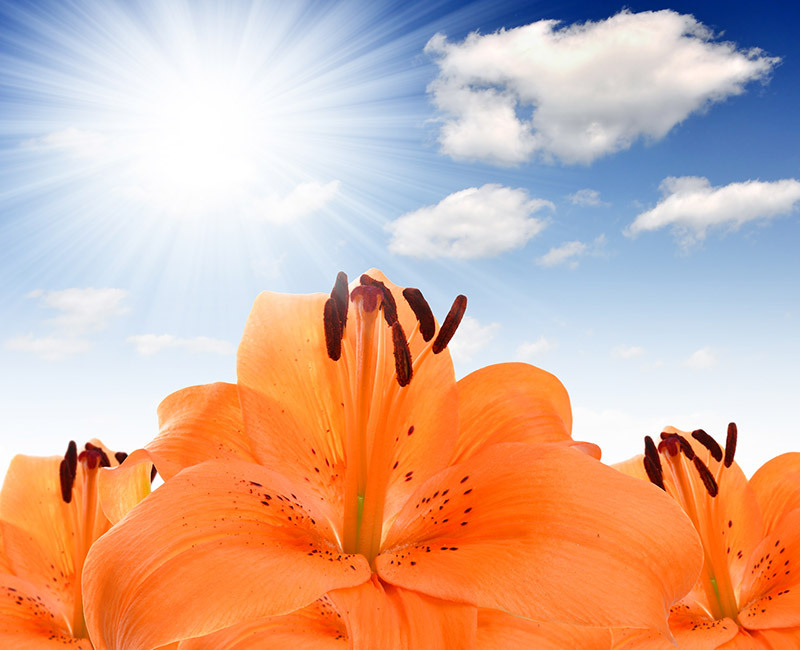The Untold Story of Sunflowers: Fascinating Facts
Posted on 01/07/2025
The Untold Story of Sunflowers: Fascinating Facts
Sunflowers, with their radiant faces and towering stalks, capture hearts and imaginations across the globe. But how well do we really know these golden beauties? Beyond their cheerful appearance, sunflowers (or Helianthus annuus) have a history and set of qualities that are as vibrant as their petals. From ancient civilizations to modern uses, ecological impacts to cultural symbolism, the story of sunflowers is as intriguing as it is beautiful. Let's dig deep into fascinating sunflower facts that may surprise you!
1. The Ancient Origins of Sunflowers
While sunflowers are closely identified with North American prairies, their untold origin story stretches back thousands of years. Domesticated over 4,500 years ago by Indigenous peoples in present-day North America, sunflowers were one of the very first crops cultivated on the continent.
- Ancient agriculturalists selected for their size and oil-rich seeds, making them a reliable and nutritious food source.
- The sunflower served culinary, medicinal, and ceremonial purposes for tribes like the Aztecs, the Otomi, and the Dakota.
- It wasn't until Spanish explorers arrived in the Americas in the 16th century that sunflowers began their journey to Europe and beyond.

2. Sunflowers: Not Just a Pretty Face
There's more to the story of sunflowers than meets the eye. While the iconic yellow petals (called ray florets) are what catch most people's attention, the center of a sunflower is actually composed of thousands of tiny tubular flowers, known as disk florets. Each of these can potentially develop into a seed, contributing to the plant's impressive productivity.
The Fibonacci Connection
One of the most astounding facts about sunflowers is their relationship with mathematics. The spirals in the head of a sunflower follow the Fibonacci sequence -- a natural pattern that allows the plant to pack as many seeds as possible into a single flower head.
This mathematical marvel ensures both optimal seed arrangement and maximum reproductive success!
3. Sunflower Heliotropism: Following the Sun
Heliotropism is the unique behavior of sunflowers, especially noticeable in young plants, where the flower heads track the movement of the sun across the sky.
- During the day, young sunflowers face east in the morning and follow the sun to the west by evening.
- At night, they reset their orientation to face east again, ready for sunrise.
- This adaptation helps maximize photosynthesis and promotes healthy growth.
4. Fascinating Sunflower Varieties
There are about 70 species of sunflowers within the genus Helianthus, each with distinct features, colors, and growth habits. While most people picture the classic bright yellow, single-headed sunflower, the family is much broader:
- Dwarf sunflowers: Perfect for urban gardens and potted displays.
- Giant varieties: Some can reach heights of more than 12 feet, with enormous heads the size of beach balls.
- Multi-headed sunflowers: These varieties bloom with a profusion of smaller flower heads on a single stem.
- Colorful cultivars: Sunflowers also come in rich reds, oranges, and even bi-color patterns.
5. The Global Journey: From Fields to Feasts
Sunflowers spread from their North American homelands to the rest of the world in the 16th century, thanks to Spanish explorers. In Russia, sunflowers became integral to culture and cuisine--especially after the Orthodox Church banned most oil-based foods during Lent, but not sunflower oil because it was a novel ingredient.
- Today, Russia and Ukraine are the leading producers of sunflower seeds and oil.
- Sunflower oil is a staple in global cooking due to its mild flavor and high smoke point.
- Sunflower seeds are enjoyed roasted, raw, and as ingredient in snacks and nutrition bars.
6. Sunflowers in Culture and Art
Few plants have inspired the human imagination like sunflowers. Their image is loaded with symbolic meaning and artistic appeal:
- Vincent van Gogh's "Sunflowers" series: These famous paintings highlight the emotional and visual power of the flower.
- Many cultures view sunflowers as symbols of loyalty, adoration, positivity, and longevity.
- Sunflowers frequently appear in poetry, folklore, and even contemporary fashion and decor.
The Sunflower in Myth and Legend
According to a Native American myth, a young girl transformed into a sunflower so she could always face the shining light. In ancient Greek legend, the nymph Clytie turned into a sunflower after her love for the sun god Apollo. She still turns her face toward the sun's path, immortalizing the story in every sunflower field.
7. Powerful Uses: Beyond Beauty
While sunflowers win hearts with their looks, their utility is no less remarkable. The seeds, petals, stems, and oil deliver a cornucopia of uses in medicine, cuisine, agriculture, and industry.
- Sunflower oil is rich in Vitamin E and used for skin health and cooking.
- Edible sunflower seeds are packed with protein, healthy fats, and minerals.
- Stalks can be used as biodegradable building materials or as silage for livestock.
- Sunflower extracts show promise for removing toxins from polluted soils--an amazing property known as phytoremediation.
8. Eco-friendly Champions: Sunflowers and the Environment
Sunflowers are not just beautiful--they're also environmental allies with benefits for humans and wildlife alike.
- Attracting pollinators: Sunflowers draw bees, butterflies, and birds, supporting local ecosystems.
- Soil health: The deep taproots of sunflowers break up compacted earth, enhance soil aeration, and even absorb excess heavy metals and toxins.
- Renewable resource: Sunflower oil makes an eco-friendly biodiesel, offering a greener alternative to fossil fuels.
During the Chernobyl nuclear disaster cleanup, scientists planted sunflowers to help reduce radioactive contaminants in soil and water--a real-world testament to their cleansing power.
9. Astounding Sunflower Records
- Tallest sunflower: The Guinness World Record for the tallest sunflower stands at a staggering 30 feet, 1 inch (9.17 m), grown in Germany in 2014.
- Largest sunflower head: The record head measured over 32 inches (82 cm) across.
- Most sunflower heads on a single plant: Some varieties can generate more than 100 heads on one stalk!
10. Growing Sunflowers: Tips for Your Garden
Bringing the joy and wonder of sunflowers to your garden is easier than you might think. Follow these key steps to cultivate your own cheerful blooms:
- Choose the right variety for your space, whether a backyard plot or a sunny windowsill pot.
- Plant seeds directly in the ground after the last frost, in a sunny location with well-draining soil.
- Space seeds adequately: Give giant sunflowers at least 1.5 to 2 feet between plants.
- Keep the soil moist (not soggy) during germination and seedling stage.
- Support tall varieties with stakes if exposed to wind.
- Encourage pollinators by cultivating companion flowers nearby, such as lavender, cosmos, or marigold.
- Harvest seeds after the backs of flower heads turn brown, if you wish to enjoy roasted seeds or replant next year.
11. Surprising Facts You Didn't Know About Sunflowers
- Sunflowers have inspired scientific breakthroughs in acoustics. Their ability to absorb and reflect sound has applications in architectural design.
- They're not just one flower! Each "sunflower" is actually a dense aggregation of hundreds--or even thousands--of mini-flowers.
- Sunflower oil can be used in organic pesticides and as a carrier in pharmaceuticals.
- In some cultures, sunflower leaves are brewed into tea believed to fight fever and inflammation.
- Wild sunflowers can range in appearance from tiny, bush-like plants to sprawling vines, all with characteristic round faces.
- Sunflowers can "communicate" with each other--young plants seem to synchronize their movements to maximize energy intake, a phenomenon still being studied.
12. Sunflowers in Today's World
Sunflowers continue to play a prominent role in contemporary society--not just as decoration or crop, but as powerful symbols of resilience and hope.
- They have become symbols of peace and resistance, recently adopted as a national emblem by countries facing hardship.
- Sunflowers remain a staple in the fields of the world's leading exporters, ensuring global food security and sustainability.
- With their natural ability to remove toxins and provide resources for pollinators, they stand at the forefront of sustainable agriculture and environmental restoration.

Conclusion: The Timeless Appeal of Sunflowers
From ancient crop to modern marvel, the untold story of sunflowers reveals a plant of astonishing utility and cultural significance. They are much more than a pretty backdrop or a source of crunchy seeds--the sunflower is a global icon, an ecological powerhouse, a mathematician's muse, and a symbol of hope for generations to come.
Let the sunflower's story inspire you to see these yellow giants with fresh eyes. Whether in the wild, in art, or in your own garden, sunflowers continue to shine as nature's gift of beauty, resilience, and remarkable secrets yet to be discovered.
Frequently Asked Questions (FAQ) about Sunflowers
- How long do sunflowers live? Most annual sunflowers complete their lifecycle in a single summer, but perennial species can return for several years.
- Are sunflower seeds safe for pets? Plain, unsalted seeds are generally safe for most pets in moderate amounts, but always consult your veterinarian first.
- What do sunflowers symbolize? Sunflowers typically symbolize positivity, loyalty, adoration, and long life.
- Can I grow sunflowers indoors? Yes! Dwarf varieties are perfect for sunny windowsills and containers.
Ready to grow your knowledge and your garden? Start with a few sunflower seeds and discover just how fascinating these bright blooms can be!
Latest Posts
Explore How Your Birth Flower Reflects Your Nature
The Origin of Love: Red Roses as Valentine's Emblem
Essential Practices for Hydrangea Maintenance





